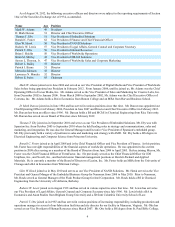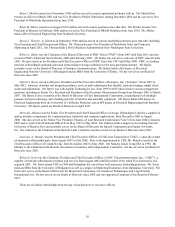Crucial 2012 Annual Report Download - page 20
Download and view the complete annual report
Please find page 20 of the 2012 Crucial annual report below. You can navigate through the pages in the report by either clicking on the pages listed below, or by using the keyword search tool below to find specific information within the annual report.19
Our net operating loss and tax credit carryforwards may be limited.
We have a valuation allowance against substantially all U.S. net deferred tax assets. As of August 30, 2012, our federal,
state and foreign net operating loss carryforwards were $3.5 billion, $2.2 billion and $737 million, respectively. If not utilized,
substantially all of our federal and state net operating loss carryforwards will expire in 2023 to 2032 and the foreign net
operating loss carryforwards will begin to expire in 2017. As of August 30, 2012, our federal and state tax credit carryforwards
were $208 million and $203 million respectively. If not utilized, substantially all of our federal and state tax credit
carryforwards will expire in 2013 to 2032. As a consequence of prior business acquisitions, utilization of the tax benefits for
some of the tax carryforwards is subject to limitations imposed by Section 382 of the Internal Revenue Code and some portion
or all of these carryforwards may not be available to offset any future taxable income. The determination of these tax
limitations is complex and requires a significant amount of judgment by us with respect to analysis of past transactions.
Changes in foreign currency exchange rates could materially adversely affect our business, results of operations or
financial condition.
Across our multi-national operations, there are transactions and balances denominated in currencies other than the U.S.
dollar (our reporting currency), primarily the Singapore dollar, euro, shekel and yen. We recorded net losses from changes in
currency exchange rates of $6 million for 2012, $6 million for 2011 and $23 million for 2010. Based on our foreign currency
exposures from monetary assets and liabilities, offset by balance sheet hedges, we estimate that a 10% adverse change in
exchange rates versus the U.S. dollar would result in losses of approximately U.S. $8 million as of August 30, 2012 and U.S. $9
million as of September 1, 2011. In the event that the U.S. dollar weakens significantly compared to the Singapore dollar, euro,
shekel or yen, our results of operations or financial condition may be adversely affected.
In connection with the Elpida sponsor agreement and Rexchip share purchase agreement, we entered into currency option
transactions to mitigate the risk that increases in exchange rates have on our planned yen and New Taiwan dollar payments. We
estimate that, as of August 30, 2012, a 10% decrease in exchange rates for the yen and New Taiwan dollar compared with U.S.
dollar would result in losses of approximately U.S. $108 million for these currency options. Additionally, we estimate that, as
of August 30, 2012, a 10% decrease in exchange rates for the yen and New Taiwan dollar compared with U.S. dollar would
result in a decrease of U.S. $239 million of our planned payments under the Elpida sponsor agreement and Rexchip share
purchase agreement.
We face risks associated with our international sales and operations that could materially adversely affect our business,
results of operations or financial condition.
Sales to customers outside the United States approximated 85% of our consolidated net sales for 2012. In addition, a
substantial portion of our manufacturing operations are located outside the United States. In particular, a significant portion of
our manufacturing operations are concentrated in Singapore. Our international sales and operations are subject to a variety of
risks, including:
• export and import duties, changes to import and export regulations, and restrictions on the transfer of funds;
• compliance with U.S. and international laws involving international operations, including the Foreign Corrupt
Practices Act, export control laws and similar rules and regulations;
• political and economic instability;
• problems with the transportation or delivery of our products;
• issues arising from cultural or language differences and labor unrest;
• longer payment cycles and greater difficulty in collecting accounts receivable;
• compliance with trade, technical standards and other laws in a variety of jurisdictions;
• contractual and regulatory limitations on our ability to maintain flexibility with our staffing levels;
• disruptions to our manufacturing operations as a result of actions imposed by foreign governments;
• changes in economic policies of foreign governments; and
• difficulties in staffing and managing international operations.
These factors may materially adversely affect our business, results of operations or financial condition.
























